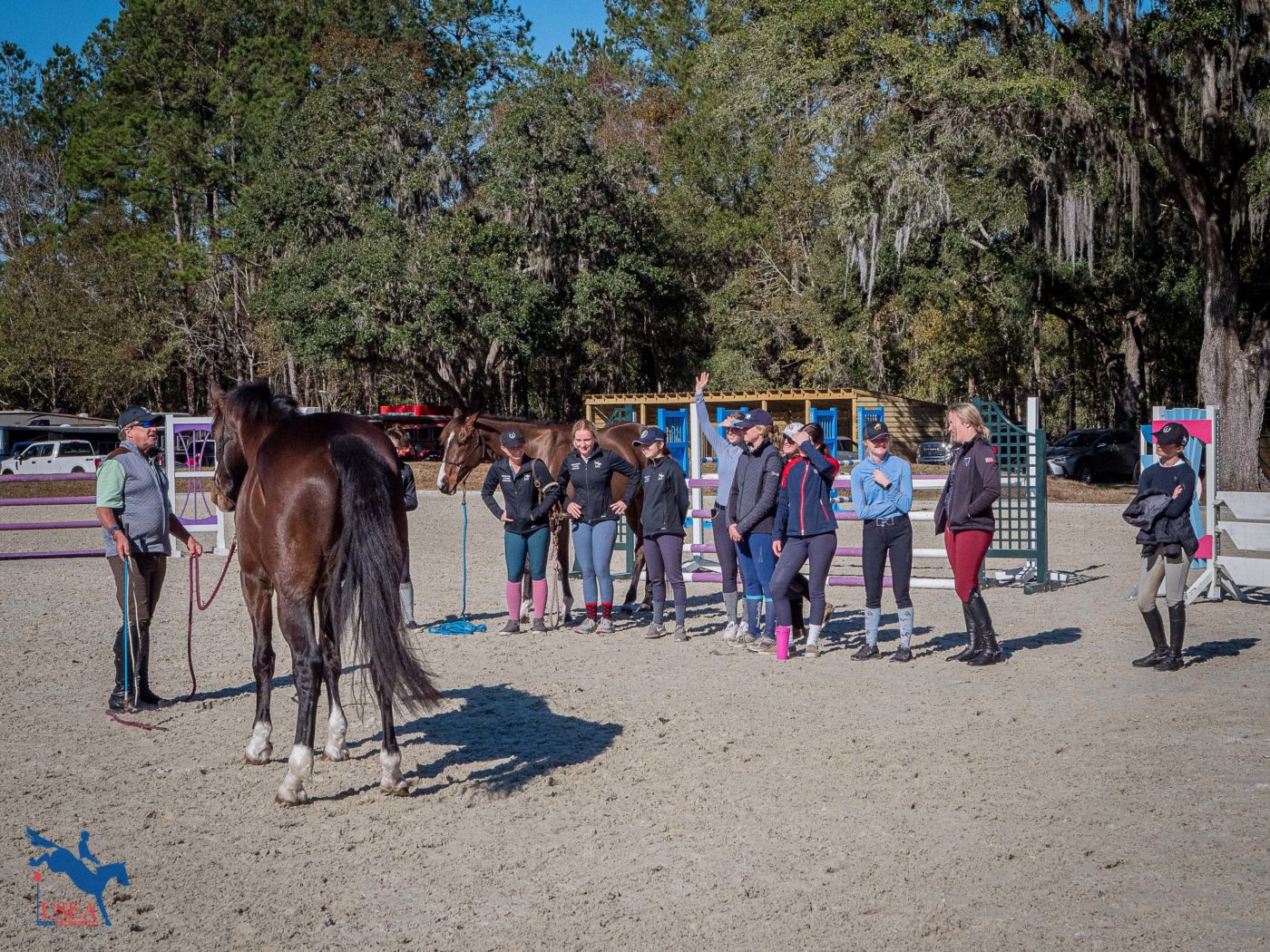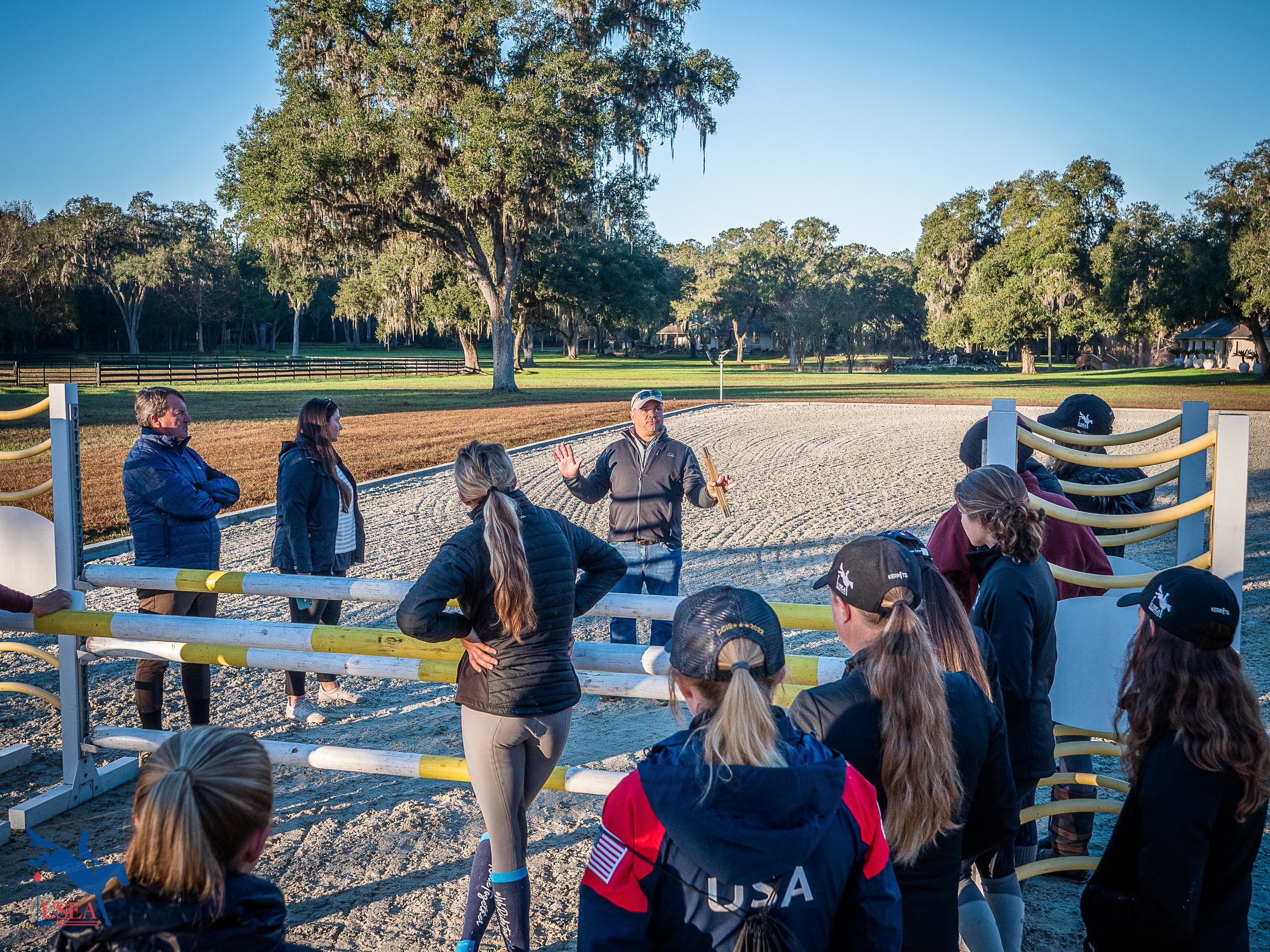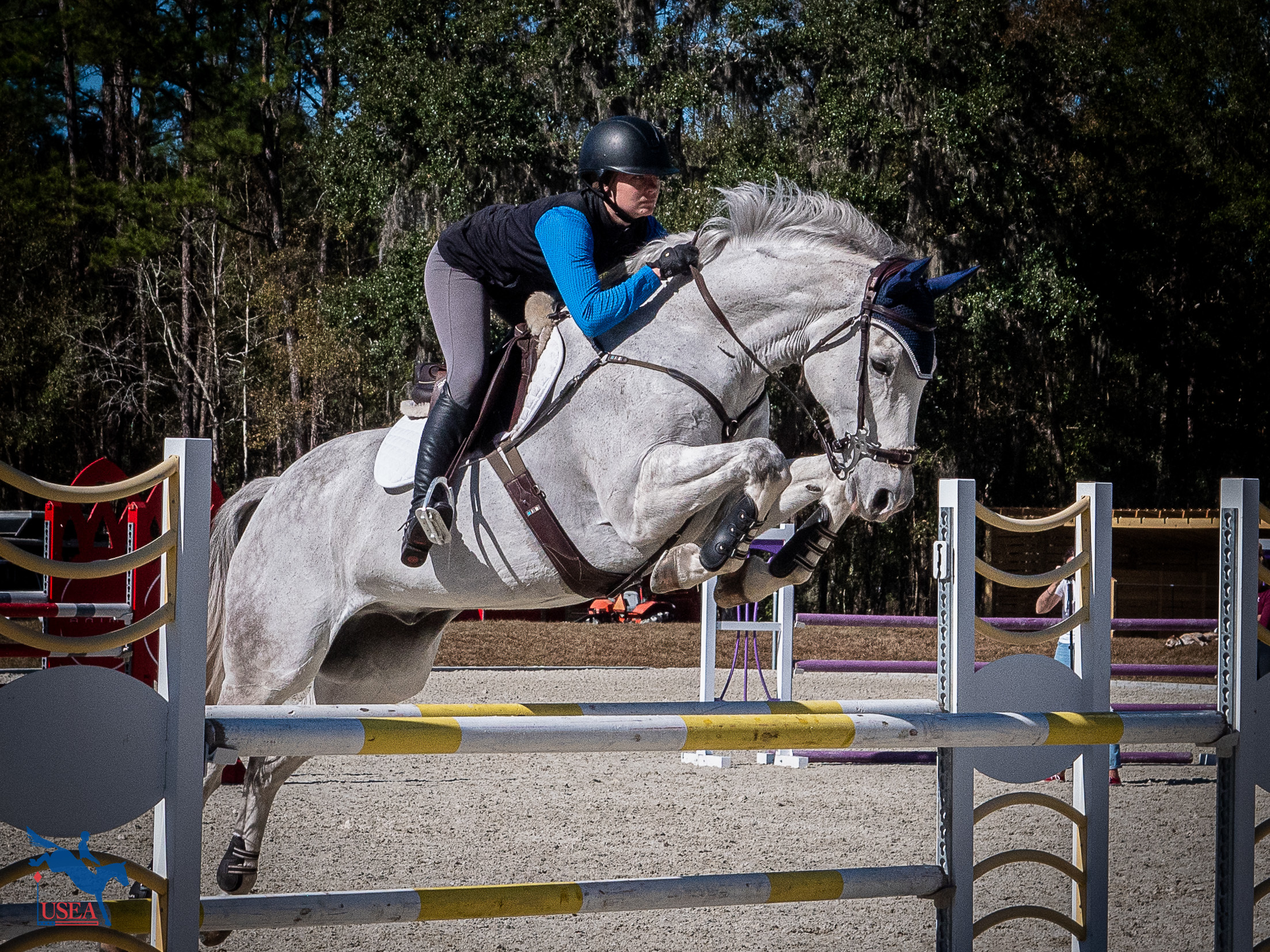Renew Your USEA Membership for the 2023 Season Today LEARN MORE

It was back to show jumping for the final day of the 2023 USEA EA21 National Camp. This year’s participants kicked off the last day learning about course design and beneficial groundwork concepts.
Bright and early this morning, the riders set up a schooling jump course with eventing show jumping course design expert Chris Barnard. Barnard walked the course with participants, discussing striding and why he set the lines in the manner that he had. One of the big takeaways that Barnard discussed was the importance of color choice for elements of a jump course. He explained that thought needs to be given to how the horse perceives color in choosing colors for each jump. Key considerations included: The color yellow can be perceived similarly to the arena footing to horses, so if yellow is incorporated on course, it must be striped. Similarly, red and green are viewed by horses in the same way, which is why a cross-country jump should never be red so as to not blend in with the green grass footing.

In terms of course design, Barnard touched on the fact he usually begins his courses with an oxer. This helps the horse to get going and tackle the course. If the course starts with a vertical, the horse will have the tendency to slow down for the course. Barnard also talked about how he usually incorporates a plank jump. These jumps have flat cups on the top and require more set-up for the riders to go over them successfully. Between what Barnard and EA21 Director of Coaching David O’Connor touched on during the course design lecture, it was discussed how important it is for riders to expose their horse to a variety of jumps and how taking your horse to straight show jumping competitions is extremely beneficial. Over the years, the show jumping phase has gotten more difficult and the riders have gotten better, so preparing for lots of different scenarios can help riders to be successful and competitive. After discussing course design and different elements of a jump course, the riders went out to ride it themselves.
The mounted portion of the day consisted of a fix-a-course type lesson. Each rider warmed up with pointers from O’Connor, then jumped the course like in a show. Afterward, O’Connor discussed with each rider how they could improve their round, before they went again. O’Connor went over helpful pointers for the warmup and after entering the ring before their jump round. During their warmup, O’Connor noted that riders can have their horses jump fences 10 centimeters above what they are running in the round. Upon entering the ring before their round has officially begun, it is very important for riders to utilize the 45 seconds they have before getting to the start line after the bell rings. A rider should use that time and have their horse lengthen, shorten, and rein back before passing the start line. While on course, O’Connor stated they need to not turn too early and end up going over a fence on a crooked line, but rather they should wait to turn and approach the element square.
The riding portions of the day had a break mid-morning for a segment talking about groundwork. O’Connor talked about laying a foundation with the horse on the ground that will prepare them for work in the saddle.
“Riding is putting pressure on and taking pressure off. So, why not teach it on the ground first before you get on?” stated O’Connor. “You start to teach the language of how you’re going to speak to them [in groundwork].”
EA21 participant Julia Beauchamp Crandon was excited to take what she had learned about groundwork back home to Redwood City, California, and incorporate it into her program with her own horses. “I think that it’s going to be really influential to my horses at home because I haven’t done a ton of groundwork, and so I’m excited to learn about how you can gain more respect from the horse and how that can transfer to them further in your riding.’

O’Connor also specifically touched on the four yields that can be done with horses: backing up, the forehand yield, the hind end yield, and bringing their head down. If a rider applies pressure in front of the horse, this will result in the horse moving sideways or backing up, while applying pressure behind the shoulder will result in the horse moving sideways or forward. O’Connor illustrated these with his seasoned event horse and then showed the riders how to work on these concepts with a less-experienced horse. His big takeaway from this exercise was that as a horse gains more experience, the intensity of the cues should lessen and become more subtle.
Reflecting back on the week and what she learned, Sarah Ross (Reno, Nevada) shared her big takeaway lesson: “Really knowing where you’re at and to pay attention to every step because every step matters, plus staying on your line and not be willing to neglect that is a huge thing that I’ll be going home with. The willingness to change yourself depending on the horse you’re on, I’ll really take back home with me.”
For those considering applying for the 2023 EA21 Regional Camps in hopes of being selected to participate in the 2024 EA21 National Camp, Ross shared: “I’d say apply no matter where you think you’re at qualification-wise. At the regional clinic, I was one of the least experienced riders there, I’d only gone Training level. You just always have to apply because regardless of the situation, it’s always an opportunity to learn whether you get in or you don’t. You’re learning how to apply for different things for the future. And as far as the program itself goes, don’t be afraid to ask questions, that’s what they’re here for. So when you are here, get the most out of it.”
Beachamp Crandon echoed Ross’ sentiments stating, “[you should] always apply because this is a really educational program and you learn so much from coming to these things. Like David’s been saying, you’ll probably be working with these people for the rest of your life if you stay in the business of horses and compete up to the highest of the levels. You might even be on teams hopefully with these people, so it’s nice to get to know them and figure out who you think will help you further and how you can work with them in the future.”
Whether they were riding their own horse or hoping on a catch ride for the week, each rider shared how beneficial the weeklong camp led by O’Connor was. Over the course of this week through participating in the first-ever EA21 National Camp, not only were the riders able to gain new insight to improve in their sport, but they were able to make connections in the industry that could last a lifetime.
Review all of the coverage from the EA21 Camp here.
About the USEA Emerging Athletes 21 Program
The purpose of the USEA Emerging Athletes 21 program (EA21) is to identify and provide consistent quality instruction to the next generation of elite event riders. The aim is to create a pipeline for potential team riders by identifying and developing young talent, improving horsemanship and riding skills, and training and improving skills and consistency.
The USEA Emerging Athletes 21 Program was launched in 2022 with a model of five summertime regional clinics taught by selected USEA Eventing Coaches Program (ECP) instructors, leading to a winter national camp consisting of selected Young Riders from the regional clinics. Athletes who are 21 years or younger, are current members of their USEA Young Rider Area program, and are established at the Training Level or higher, are eligible to apply for the EA21 program. Applications for the 2023 regional clinics will open in January/February 2023.
The USEA would like to thank Kerrits, WeRideTogether, and Ride iQ for their support and sponsorship of the EA21 national camp.